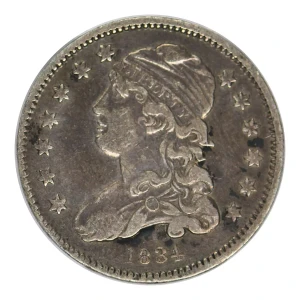The Capped Bust design appeared on the United States half dimes, dimes, quarters, and half dollars from 1807 to 1839. It was conceived by John Reich, a German immigrant who accepted the position of U.S. Mint Assistant Engraver at the recommendation of Thomas Jefferson in 1807. His first task was to redesign the circulating coinage of Chief Engraver Robert Scot. Like other Capped Bust coins, the obverse of the Capped Bust quarter features Liberty, facing left, wearing a headband with the inscription LIBERTY, as well as a Phrygian Cap. The latter was originally worn by emancipated slaves of ancient Rome and was a popular symbol of freedom during the American Revolutionary War. Thirteen stars surround the bust, representing the original states in the Union. The reverse features an American Bald Eagle with outstretched wings holding an olive branch and a bundle of arrows in its talons. A scroll above the eagle includes the motto E PLURIBUS UNUM. The denomination appears at the bottom, which had not been consistently employed on earlier designs of U.S. coinage. The Capped Bust quarter was produced sporadically from 1815 to 1838 and underwent a size reduction in 1831, thus rendering 2 major varieties in this popular but short-lived coin series.


